No Results Found
The page you requested could not be found. Try refining your search, or use the navigation above to locate the post.
In a few seconds of landing on your website, your potential customers have already had their first impression of your company. Your home page is like your home entry door, visitors do not stay there for long, but they expect it to be cleanly kept, and welcoming. Let’s see what do you need to create great home page content?
Keep in mind, attention span is short.
Your home page content needs to give them a clear sense of who you are and what you do and invite them to explore additional pages, learn more about your services. If your page is not what they expected and do not have a clear message, they will leave immediately.
The homepage is to grab attention, warm up your audience, take them on a user journey, to create credibility so at the end of the page your visitors trust you and will be ready to take action.
People find it easier to talk about the different services they offer, but if you offer more than one service, then the homepage is not the best place to go into details. You will have plenty of space on the services pages to explain what you do.
Here are a few key things to make your homepage better.
It sounds simple, but many business owners do not have a defined audience in mind. So ask these questions first.
If you are able to answer these questions, that helps you to figure out what content and messages your audience will care about. Once you know your audience, it is easy to connect with them.
(Marketing Evolution has a great article on why it is important to decide your target audience)
You can have the sleekest, most stunning website design, but if visitors can’t understand what you do within seconds, you’re going to lose them. Your top message is the attention-grabbing topic that makes them stop scrolling and pay attention to you.
Take a look at this header. Uber’s website is very clear about what it can do for people who are looking for work. The drivers are the main target, they can get all the information within reach from the top section of the website.
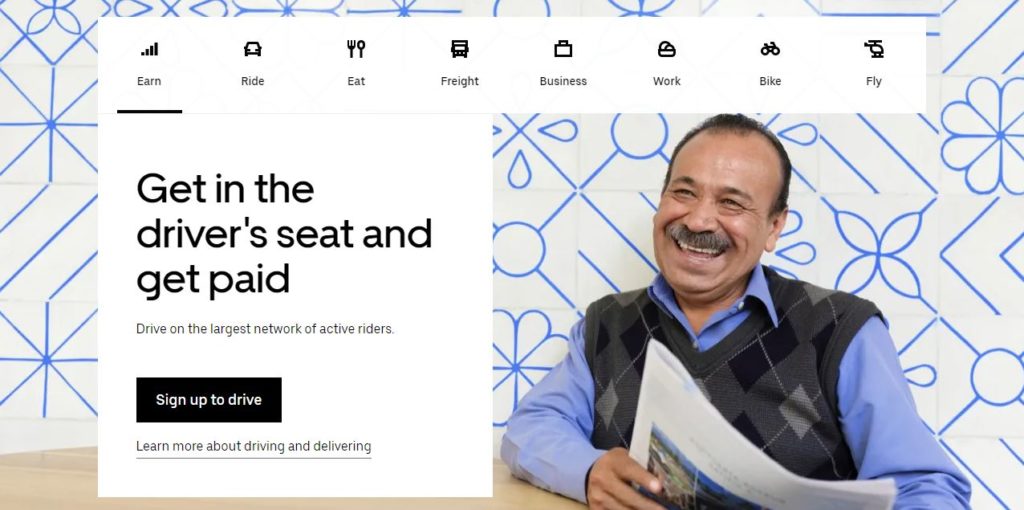
The value proposition is a statement that explains why people should choose your service over that provided by your competitors.
This should identify all the benefits that your services or products offer and describe what makes those benefits valuable. It should be easy to understand, define what you do, make it clear who you want to work with, and explain how you solve their problem.
Knowing your target audience, you will understand the problems they face. Being specific about what problem your product/service solves for them helps too.
Like:
Outdated old website? – We provide modern, user and mobile-friendly websites for local businesses.
Great website but no traffic? – We can improve website visibility with search engine optimization.
Need Google Business Listing? – We can help with GMB optimization.
There are very few businesses that do not have fierce competition. Tell visitors what sets you apart and why they should use your service instead of the other guy’s similar one. Be more accurate than, “We have the best people” or “We have the most efficient process”. Make it clear what makes you different, and be specific.
People trust real people. Show them customer success stories. Be short and specific.
You can grab a couple of testimonials from your Google Reviews and add them to your home page. I prefer adding testimonials spread out across pages, rather than dedicating a page solely for them.
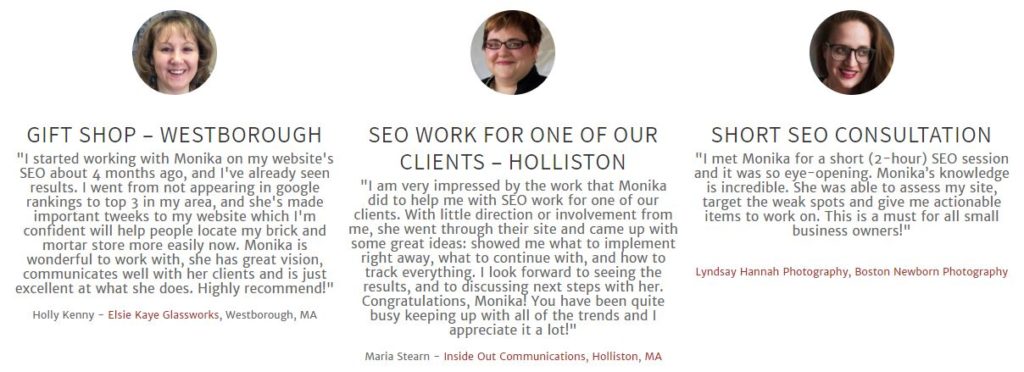
If you can, add names, companies or, logos to strengthen your credibility.
Search engines look for keywords to determine where to place you in their directories or listings. Make sure your home page content includes words associated with your business and more importantly that your prospect is likely to use looking searching for help.
You need words and the right words.
Search engines do not care about your website layout, or background color, or images. Therefore some professionals, like photographers have a hard time ranking their websites, which are full of images, but lack words.
A search engine-friendly home page needs a keyword-rich content copy.
The goal of your website is to get visitors to take action. The best way to create buttons using action verbs like, Buy Now, Sign Up, Download this, or that.
Make your website mobile-friendly, and easy to navigate. Your visitors should be able to instantly determine where to locate the information they need. My approach to home page design is to add as much info as possible to the home page. Mobile users scroll up and down easily, but it is harder for them to click on the menu on the top.
The home page should promote your inner pages with easy hyperlinks or buttons.
Images reinforce the message. Have you heard that “an image is worth a thousand words”? Most of the time visitors do not read all the words but scan the page to look for clues. Therefore it is good to use images. Visitors can emotionally connect to images and that is what makes it so powerful. Unique images grab attention easier than words.
Cornerstone content is perhaps the most important part of your website SEO strategy. A cornerstone piece covers a topic or concept completely. This essential piece of content should be informative and timeless, so it retains its relevance. You may need to update it from time to time to keep it up to date. A cornerstone article will be long and informative. The intent is not to sell products, but rather it plays a huge role in your SEO strategy and helps to drive traffic.
An actual cornerstone is part of a foundation for a building. It is in place before the construction of the building. It’s a valuable part of the structure. Knowing what an actual cornerstone is helping with the understanding of what cornerstone content does for your site. It’s a piece of content that has high value and creates a foundation other content can be built upon. The goal of cornerstone content is to help build traffic and brand awareness. It should align with and be relevant to your business goals. Cornerstone content helps establish you as an authority in your industry. But it also helps bring visitors to your site who are likely to be interested in your products or services at some point along the way.
One thing to understand about cornerstone content is that it is at the top of the sales funnel. It should be easily accessed and not hidden behind a registration form or paywall. The primary goal of these types of articles is to provide a great first impression and a lot of information to your readers. It’s designed to support the structure of other content and perform as a traffic base. It can function as a blog post or be a page on your site.
Like a cornerstone is essential for keeping a building together, cornerstone content is something you can hand your whole content strategy on. It’s an epic piece, an incredibly useful resource for your business and site visitors. But how do you know how to choose a topic for a cornerstone piece and then build it out so it’s most effective? Remember that this piece must be seen as valuable to site visitors. Here are some steps to help you choose a topic and create stellar content.
1. Find a topic. You’ve done keyword research and evaluated your audience, take that a little further. Look for a topic from your area of expertise that people are searching for. Think of your content as the answers or information they want or need. Use relevant keywords to plan the article.
2. Choose a format. All cornerstone content doesn’t have to be a blog post or article. Even though most of the time it is in long-written form, there is no hard rule that it has to be. Your audience might prefer a how-to guide or a video series. You may want to create an infographic, a searchable database, or a free tool or app. Finding the right format is crucial to engaging your audience. Just remember that even if you choose videos or other non-textual-based content, you’ll need plenty of text to go with it.
3. Create the content. If your site is content-rich, you may have content that can be repurposed. You may want to combine and update some of your present content to create a cornerstone page. If you do not, you can create original content that is well-researched and thought out.
4. Optimize the content. Optimize your cornerstone content by including a solid header structure, alt text for images, metadata, and an internal linking structure. And always include social share buttons so it’s easy for your audience to share with a single click.
High-quality, unique content is an essential part of a successful SEO strategy. Cornerstone pieces offer a great foundation to build on when it comes to SEO. Here are five reasons it is relevant to SEO.
· Keywords – After keyword research, you’ll know which terms your audience is using for searches. You can drive traffic by answering the questions people are already asking.
· Title Tags & Headlines – While SEOs may argue about exactly how to optimize the title tag, it is definitely an opportunity to speak to your readers in the words they chose. Wrap the exact question searchers used in their query for the best results.
· Internal Link Structure – Cornerstone content is designed to help with your site’s internal linking structure. While the content is not necessarily salesy, it can be used to link to relevant products and services you are trying to sell. Google also likes to see solid internal linking.
· Header Structure – Search engines like to see content well organized by well-placed headers. They are ideal places to put primary keywords and longtail keywords.
· Stellar Content – Engaging content is the powerhouse that other SEO elements are hung on. It’s most important to create articles and posts that answer user’s questions and provides them with valuable information while focusing on the keywords and phrases already being used in search queries.
Promoting cornerstone content is about the same as promoting any of your site’s content. You may promote it using Facebook Ads, Google Adwords, or ads on Instagram or Twitter. Of course, they should be incorporated into your social media strategy and shared on the platforms you use. They can be a part of your next email campaign or incorporated into any unique marketing strategy you presently use. Using white-hat strategies to acquire backlinks to your content is a huge ranking factor.
At first, creating cornerstone content may seem a bit daunting. While it does take some effort, it’s not much different from creating other forms of valuable content, and then building linkable content to support it. Remember that quality is better than quantity, especially when you want to reach your ranking and marketing goals.
We launched a new website for a personal trainer a couple of months prior. She is inspirational and great to educate her clientele about nutrition, exercises, and sharing recipes. After a couple of blog posts were published she wanted to see if she could communicate with the readers via comments. I could truly understand that she wanted to have some feedback from the community and help others in case they have questions.
I normally don’t allow comments on blogs, because 95% is spam and it just takes too much time to manage.
But I wanted to prove my point so we let readers leave comments for 2 months.
Over 2 month period, 45 comments were left. It would be a success if these were genuine and real.
But none of them was.
Very disappointing, right?
The whole reason why spammers leave spam comments on blogs is to link back to their own websites, so they can rank higher in the search results and get more traffic. Basically, people that are shamelessly and shadily promoting their websites.
With our society being as reliant on technology as it is, encountering spam comments is increasingly inevitable. And if your website gains traction and becomes popular, the chances of receiving spam comments increases, too. But the good news is that you can avoid any spam interference in your business by learning:
Let’s break these down to give you a better idea of how to avoid scams, limit spam comments and messages, and why these things are important.
If you use WordPress to run your business’s website or blog, you’ll want to know the difference between these two important communication types. Pings are further broken down into pinbacks and trackbacks. The primary difference between the two is that pingbacks are automatic and trackbacks are manual.
Pingbacks are the automatically generated comments that appear when other bloggers link to one of your posts, or you link from one of your posts to another on your website. Trackbacks are generated by the blogger as a way to let you know that they linked to your content. These two types of pings are easy to identify and separate from comments because they contain the following:
Alternatively, a comment will contain:
Because spam comments are annoying and often time-consuming to go through and remove, many people end up just leaving them up. This can be dangerous. Spending a little bit of time monitoring spam comments can help save you a lot of trouble later. For one thing, Google might notice if your website starts racking up bad links and spam comments.
Google is concerned with the safety and security of the websites it hosts. If you let your website fill up with bad links and overflow with bot and spam comments, this essentially tells Google and your customers or readers that you’re just not that concerned with the quality of content on your website. While you weren’t the one to post them, a lack of moderation can come across as lazy or indifferent.
Think of it this way: you’re interested in purchasing a home, and today you’re visiting two identical homes that offer the same things. They’re the same size, the same number of rooms and bathrooms, same setup, same price, and they’re right next to each other, so the location is the same, too. But when you pull up, one lawn is scattered with overturned garbage cans, and trash is spilling out across the grass.
The current owners didn’t make the mess, so they decided to leave it there. When you turn and see that the other home’s lawn is pristine, that’s likely to be the one you’ll choose. First impressions are important. A website riddled with spam (virtual trash, for the sake of this example) can affect the level of trust you receive from your customers or readers and the authority you have in your market.
Generally, anything in the online world that looks suspicious is something that you should approach cautiously. Here are a few foolproof ways to identify spam comments:
If a comment meets any of these three criteria, it’s probably spam. Now, it can be difficult to tell if a person’s name looks real or fake because some are just more common than others. What you’re really looking for with the author’s name is the use of keywords instead of a real name like John or Kate. Using keywords like “personal training tips” as a name instead of a real name is a sure sign of a spam comment.
Suspicious email addresses are one of the most common indicators of spam messages. For example, if you receive an email with a subject line that tells you that your Apple account has been locked, but the email address is seemingly strange or contains random characters like this: [email protected], this is clearly not from a trustworthy source. You should also make sure that the email address aligns with the name that they used. If the name is Mary, but the email address says Nancy, that’s a red flag. If it’s close and you’re unsure, you can always use this website to confirm if an email really exists or not.
Another indicator is dodgy website URLs. Does their website look real, active, and interactive? Or does it contain strange links, zero comments, and seemingly random topics that don’t align with their comment or email address? If their website reads like clickbait, it probably is. If it looks like a spam shopping site, it’s mostly blank, or it’s otherwise suspicious, it’s questionable, and it’s acceptable to mark it as spam and move on. When in doubt, don’t respond to comments, give out personal information, open any attachments, or click on any links until you have comfortably confirmed their authenticity.
And it’s also important not to automatically click on every URL you’re sent to confirm if it’s a legitimate website. This can infect your computer with malware and lead to various other problems. The better way to investigate URLs is to install the WordPress filter, Askimet. Some versions come with it built-in already. Askimet allows you to hover over a URL and see a preview of the website. This way, you don’t always have to click on it to confirm its validity.
Spam comments are generally automatic ones made by bots. For this reason, it’s nearly impossible for them to be specific. Generic comments like “great read! Wow, thanks!” are usually spam. Comments that are relevant to the topic that you posted on, reference a specific piece of the article, or quote something from the article are more likely to be real and trustworthy. You’ll also want to look out for comments riddled with grammatical errors, improper use of language, and misspellings of common words. These are other signs that your generic comment is a spam comment.
Reducing the number of spam comments that you receive comes down to two things: trusting your instincts and installing anti-spam plugins. I can help you with both of these tasks. Askimet and other anti-spam plugins do a great job filtering spam messages out as they come in. But that doesn’t mean that some won’t get through the filter on occasion. Even after we install the filters, you’ll still want to monitor the site (or allow me to do so for you with my quality step-by-step support for your website) and stay on top of it. Schedule a free 20-minute phone call so we can go over your options for creating your website or making your existing website better.
In business, time is money. As a web designer, I help you save time and make money. One of my primary services is creating mockups for finished websites. With these incredible tools, I can show my web design clients what their website looks like on different devices. I can help you ensure that your formatting, information, and pictures look the way they should so that you can leave the best first impression on every virtual visitor.
In the past, we had to rely on Photoshop tricks and lengthy processes to achieve these results. Pulling screenshots one-by-one, putting them into Photoshop, and combining the different screens and versions is a thing of the past now that we’ve found mockup generators. Through both free and paid websites, we can create mockups simply by adding in your website’s URL.
Mockup generators take the hassle out of the process, and image-based mockup generators for graphic designers have changed the way we approach website changes and updates. We can use them to show off your designs, templates, pages, and pictures in different settings to see what looks best. They’re a useful tool in helping you create stunning, high-resolution, and high-quality images. Combine several different elements to create complex, attractive designs
These are good if you have a design that you would like to show how they will look on the screen.
For product mockups, some of the best free options are mockuper.net, mockupworld.com, and smartmockups.com.
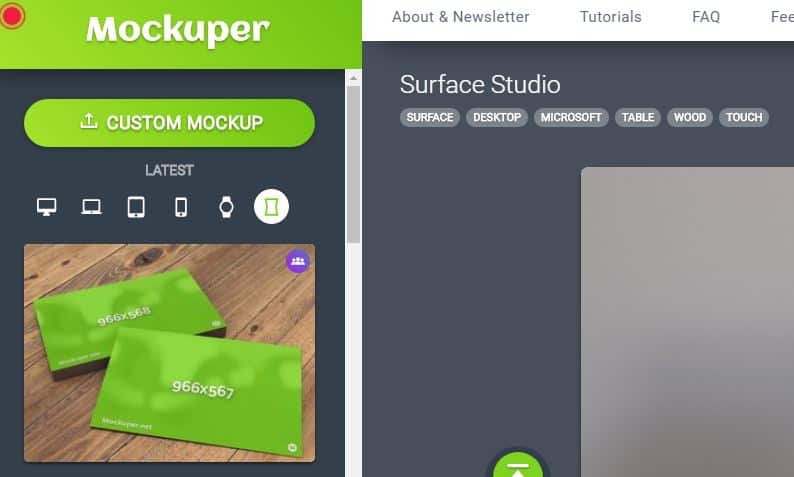
Mockuper.net offers many different options to play with. This is one of the best free options for product mockups. There are several virtual options to test, like Apple display sizes, mobile phones, tablets, and smartwatch displays. But they have plenty of print options to experiment with, as well. The print options are ideal if you’re looking to have business cards, posters, office supplies, or exhibit displays made. Confirming that your design choices look good before you put in your order can help you save time, money, and frustration.
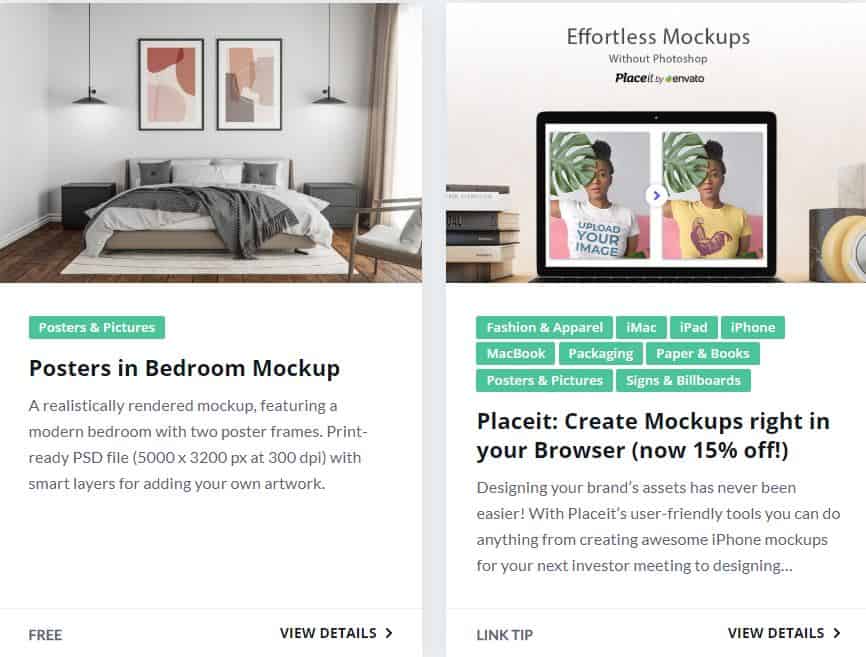
Next, we have mockupworld.com. This option gives you a great way to showcase your creative designs. There are lots of options and products available to choose from. From books and packaging to iPhones and posters, they’ve got it covered. They also offer fashion and apparel options, signs, billboards, and much more. This is an excellent resource for all designers.
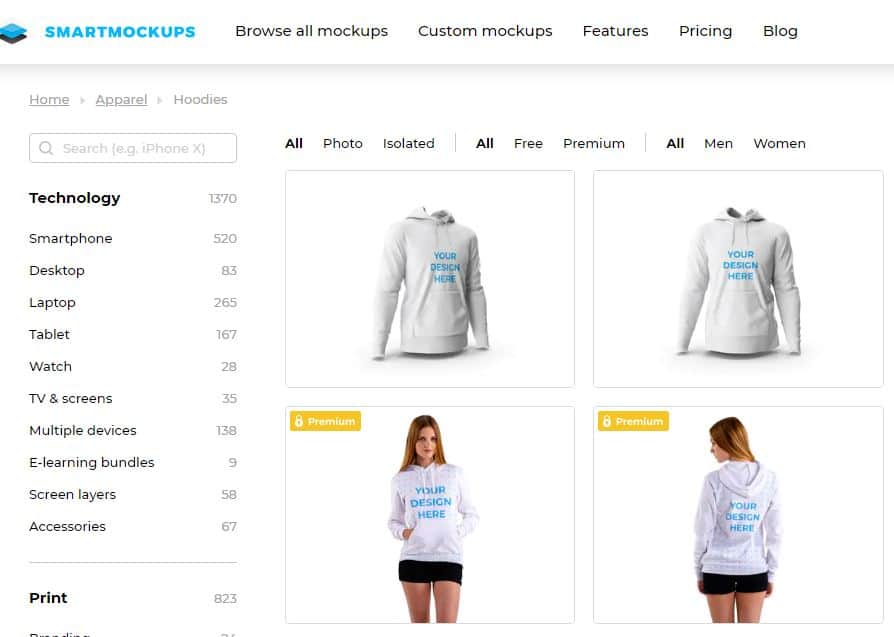
Finally, the free source smartmockups.com is a mockup haven just waiting to be explored! Digital mockups, print mockups, apparel mockups, and countless others are easy to find and explore. You can spend hours just browsing through the 185 different cosmetics, food, and beverage packaging options. There are also more than 400 apparel options, including things like tee shirts, hoodies, and tank tops.
And the home décor accessories include things like mugs, pillows, and plenty of other choices that will inspire both designers and non-designers alike. This is truly a fun, creative, and easy-to-use service! The free version gives you 200 free mockups using their basic features. After that, you may want to consider an upgrade or switch to another free mockup generator.
Now that we’ve covered product mockups, let’s talk about website prototypes.
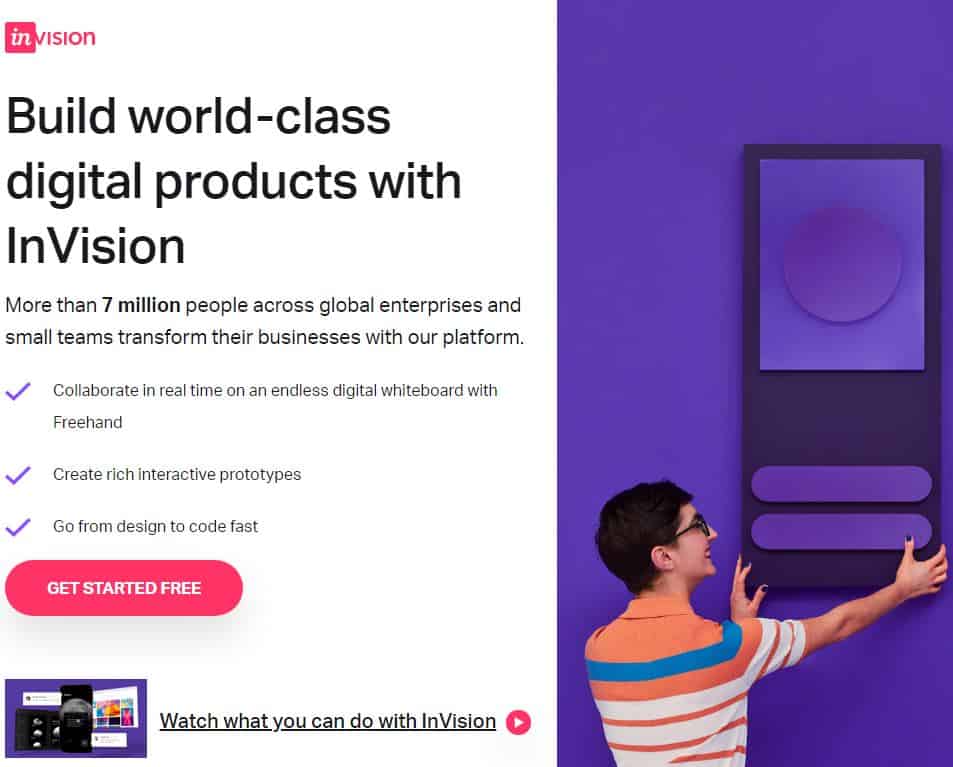
The Invision app has been a tremendous resource for many website and business owners. There are limited free options, and one of the most useful is that it can be used not only to show a simple screenshot image, but also a full page of the website. You can scroll through and get the full feeling and effect of your website at each stage.
This is a fun and easy way to ensure that it all aligns with what your ideal target customer is looking for. All you need is the right size of the image to upload, and the app takes care of the next steps. You can even add links to it. While there is a paid version with more advanced features and options, I use the free version, and I’ve found that it’s good enough for my web design business needs.
I use the FREE version and it is good enough for my webdesign business.
Last but not least, we have URL-based web design mockup generators. These are ideal for a certain type of client.
If you already have your website up and running or you’re diving into the development stage, this may be the best option for you. I primarily use these to create portfolio images and showcase new website designs. For these tasks, the following websites are tremendously valuable: techsini.com, ami.responsivedesign.is, magicmockups.com, shotsnapp.com, and screenpeek.io.
Let’s break these down:
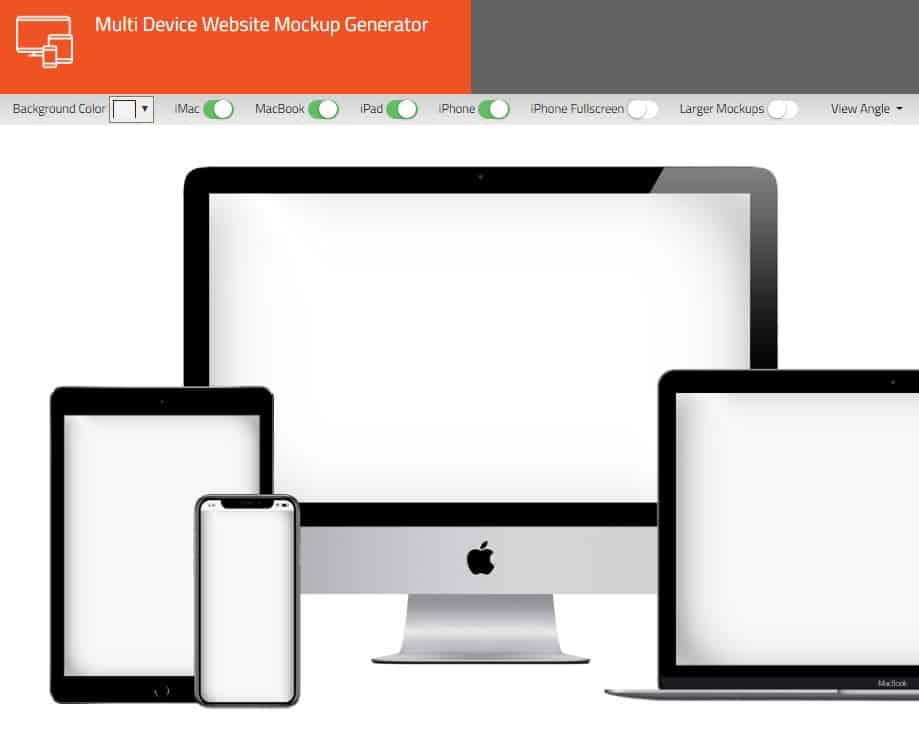
Techsini.com is a free and easy-to-use option. You just plug in the website’s existing URL, and the website shows up on the different devices you’re using. This may not sound like a big deal or like much can change, but I find that some of the features make it easy to identify inconsistencies or pieces of formatting that need to be tweaked. I like that each device could show me a different page of the same website, I can scroll through as needed, and I can eliminate some of the displays if I need to or want to see how it looks without them.
While the website is pulled up, I can also choose different colored backgrounds and angle options to see if there’s a small design tweak that will make a big difference. You can also move the devices around and make different arrangements, which I’ve found is useful in testing websites of different kinds. The only negatives: the background is not always big enough, and it would be helpful if there were more clear space at the top and bottom. But for a free mockup generator, there are small complaints.
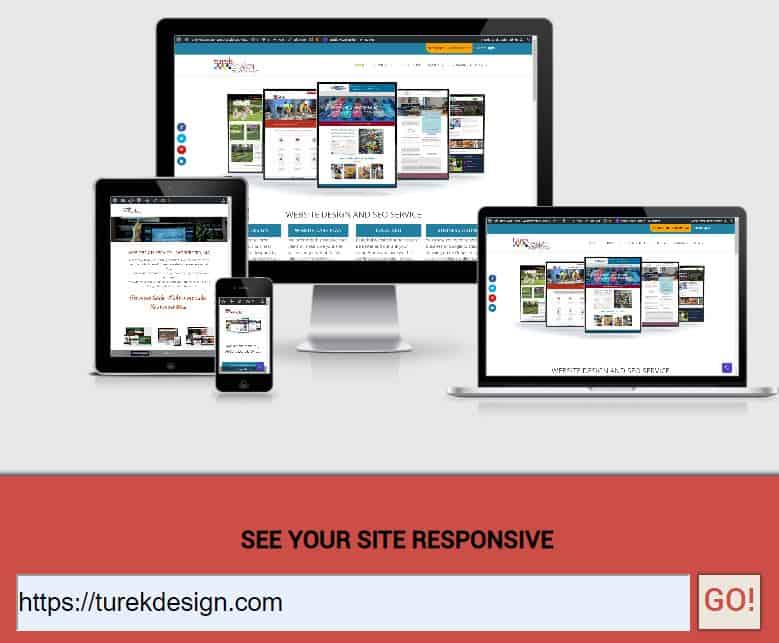
Another excellent free option is ami.responsivedesign.is. For a long time, this was my website mockup generator of choice. One of the reasons for this is that I like the way you can move the different devices to a different location. The screen scrolling is easy and smooth. The only negative here is that there isn’t much clear space on the top of the screen for a nice screenshot. This can be a bit of a challenge depending on the design of your website.
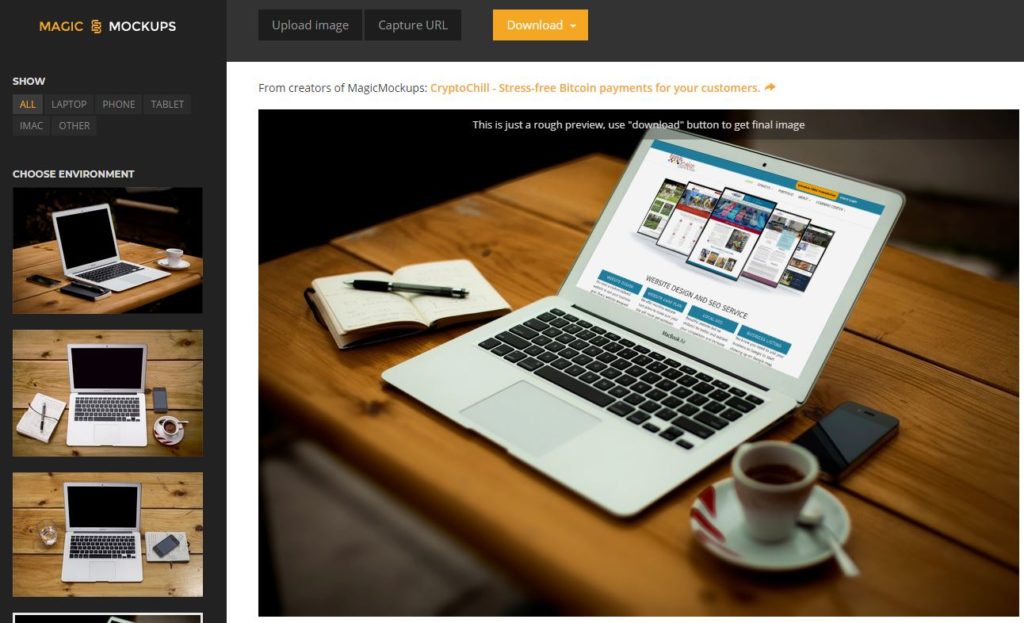
Magicmockups.com is the last fully free option on the list. They offer a great selection of stock photos of different digital devices, and they’ve recently added the URL option, which is nice! Just plug in your URL, and it’ll appear at an angle or straight on the device. One of the best things about this option is that you don’t need to take a screenshot but download a high res image instead.
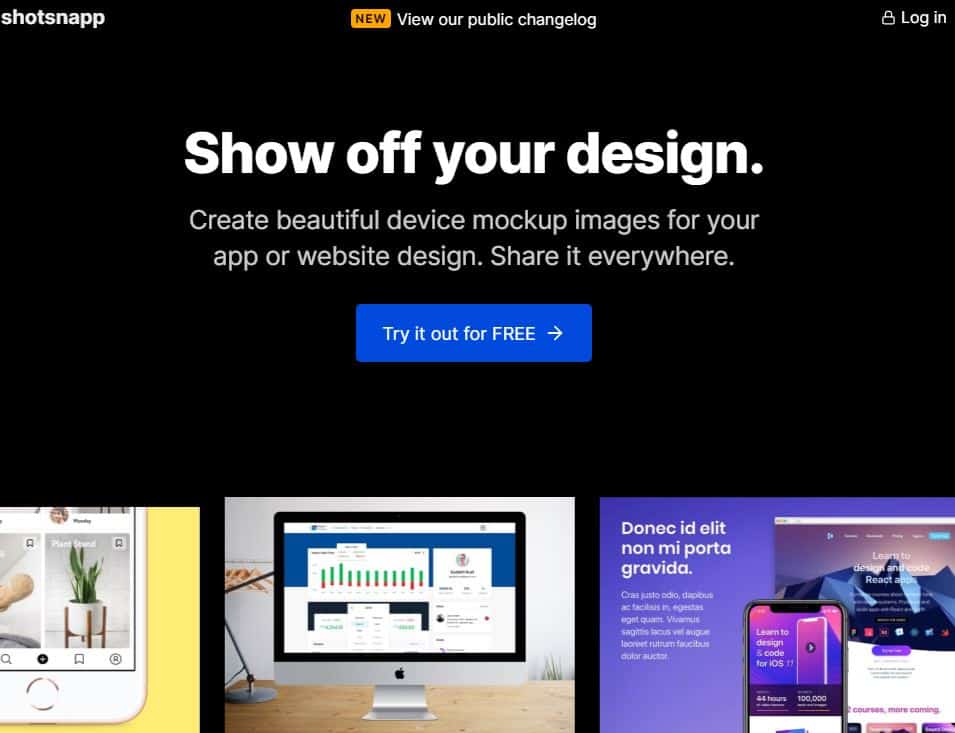
One of the newest tools in the mockup generator space is shotsnapp.com. This is the first one on the list that isn’t completely free. There is a 14-day free trial available, but that’s less time than most people will need it for, and it doesn’t give you the same features as the paid version. This app offers some impressive features that allow you to change the size of the background, change the background color, and add a drop shadow.
This option is ideal if you’re concerned with all of the tiny details that go into building and managing your website. For example, you can choose if you want your browser mockup to display as Safari, Chrome, or just a plain window, or you can choose which color iPhone you want to display.
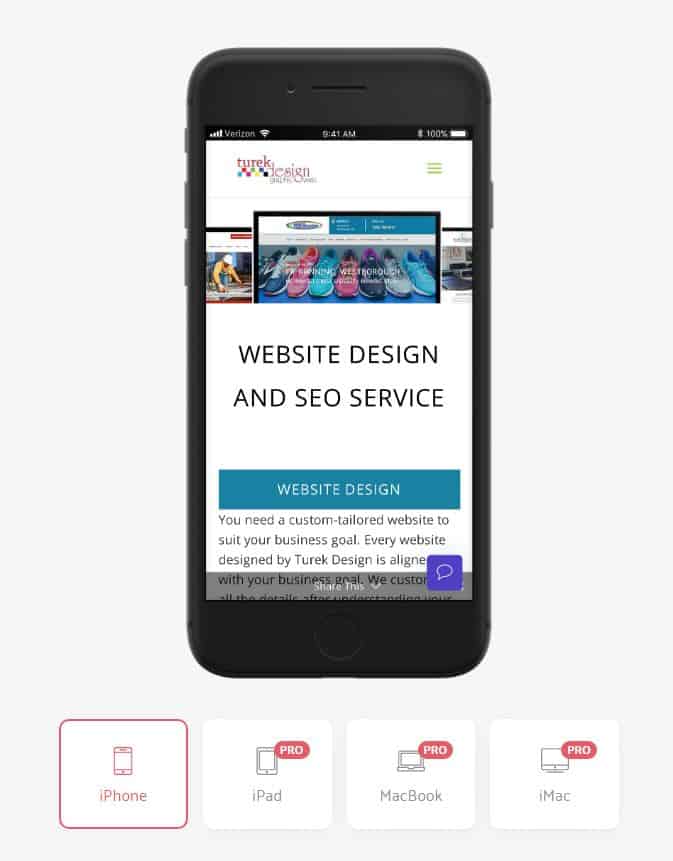
Last on our list is screenpeek.io. While this one does offer a free version, the free options are strictly limited. You can input your URL, but the free version shows only a website on an iPhone. All of the other options are paid features. It has only Mac devices, no PC or Android options available. This seems like an odd choice to me, but maybe they picked this highly-specific niche for a reason. But the paid version is a bit more expansive, and the one-time payment right now is only $12, so it may be an option worth investigating.
ONE TIME PAYMENT RIGHT NOW IS $12. REALLY WORTH IT!
Do you have a mockup generator that you currently use or have tried in the past and liked a lot?
If so, please let me know so I can add them to my list! I’d love to hear from you and keep up-to-date on market changes.
Contact me!
If you enjoyed reading this article, you should read these as well:
The page you requested could not be found. Try refining your search, or use the navigation above to locate the post.
Some people firmly believe that a Google Business listing is all you need. Others think that your success will be determined solely by your website. So, which one is it? The truth is, each of these marketing tools is valuable. They can each help you generate client leads, meet your revenue goals, attract new customers, or keep existing customers engaged, even while you’re sleeping. But while building and maintaining a website isn’t necessary for everyone, establishing your Google Business listing is.
Do you need help setting up your listing?
This free listing can act as a 24/7 marketing tool. It can help you establish credibility, attract attention, provide important business information, and offer social proof through reviews, all without a website. Still, many are hesitant about adding a Google Business Listing to their online presence. Let’s talk about why how this mindset can be hurting your business:
When it comes to GMB / how it is called in the SEO world/, your question may be, “why?” But the better question is: “why not?” Google business accounts are easy to set up and free. How many other marketing tools are truly this easy and effective? With a GMB listing, your business can rank on local searches without having a website to link back to.
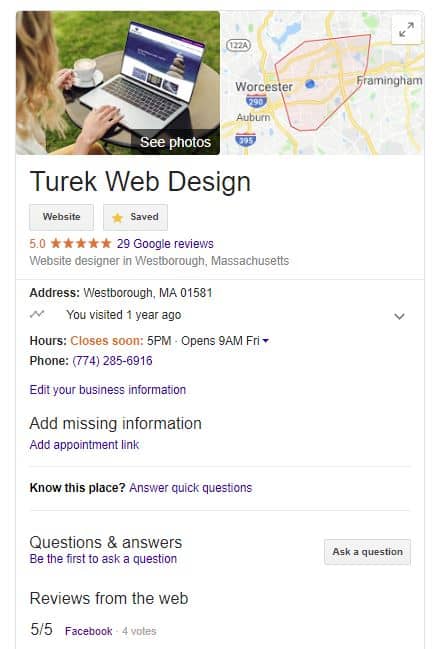
You can provide new and existing customers with all of the information they need right here. As far as basic information goes, your listing should make it easy to find:
The easier you make it for customers to find you and important information related to your business, the easier you make it for customers to choose you over others offering the same products and services. With a Google Business Listing, all of your information is stored right there on the Google server. You don’t have to worry about paying for or maintaining a website, optimizing multiple pages, or tracking its performance. Of course, having a website can also help you achieve your goals. But again, it isn’t always necessary.
Many businesses use online reviews as social proof or evidence that they’re offering a product or service that exceeds their customers’ standards. Local opinion is important when you’re choosing a service. Online marketing studies in 2019 revealed that online reviews influenced purchase decisions for 93% of consumers. Further, 97% of respondents answered that they read reviews for local businesses. With numbers this high, you may be missing out on important opportunities if you’re not highlighting your reviews and making them easy to find.
Online reviews not only generate social proof, but they also increase trust and give you a direct line to potential customers.
Many business owners, especially new ones, are afraid of getting bad reviews.
But I have a little secret for you: the occasional bad review won’t destroy your reputation.
Even the most successful businesses get a bad review from time to time.
If you get a negative review, you can balance it out with new 5-star reviews.
Luckily, there are two easy ways to do this:
Educate your new and existing customers on the importance of completing online reviews.
Many people will only leave reviews when they are very upset about the way something turned out. If your customers are generally happy with your products or services, they may not feel compelled to share that each time they come back for more. But that evidence of having repeat, loyal customers is crucial. Politely let your customers know how much a positive online review means to your business. If you’re worried that they still won’t take the time, offer an incentive. A coupon code, free sample, or other type of discount works wonders for rewarding company loyalty and initiating a positive online review.
Provide excellent customer service.
Businesses that go above and beyond are the ones that don’t have to try as hard to convince customers to leave positive reviews. If you’re providing excellent customer service and a top-notch overall experience, your customers will be happy to help. They’ll also be much more likely to take the initiative and leave a positive review on their own, making less work for you.
GMB listings have become so popular in recent years that they are essentially acting as bonus social media platforms. Right on your listing, you can:
If setting up your Google My Business page sounds daunting, don’t worry; we can handle all of the initial work for you and hand it over when it’s ready.
At Turek Design, we make it easy for you to get your information out there. It’s time to take advantage of this incredible marketing tool. We will help you create and optimize your business listing for outstanding results. Your listing can help you manage your online presence, provide social proof of your excellent customer service, attract attention, retain customers, find new ones, increase your revenue, and so much more. Why wait another day to get the word out about your business? Schedule a free discovery call today to see how we can help.
Over the years, single-page website design has become trendy and popular. They’re often visually appealing and impressively designed with large images and lots of information added on a single, easy-to-navigate page. A single-page website design is clean, easy, and modern. These are a few reasons that so many people choose them. But there’s one thing that many of these website builders and managers aren’t considering: the SEO (search engine optimization) aspect of these web pages.
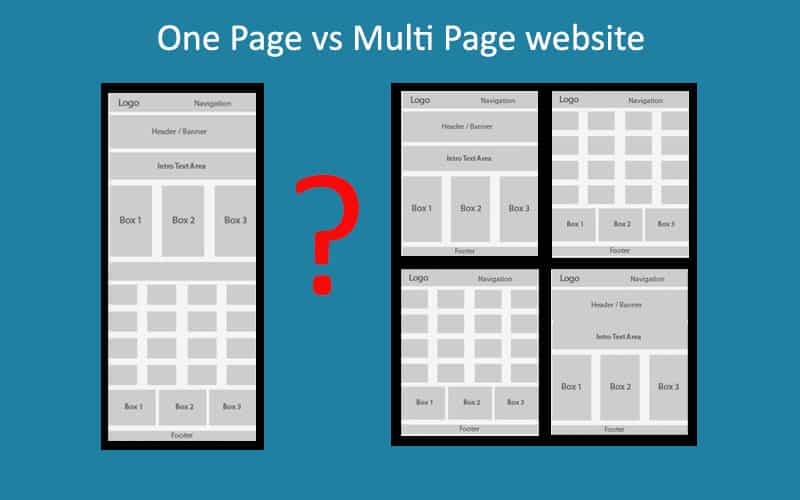
To put it simply, I’ll ask you to stop for a moment and consider this: can you fit all of your business and service information onto one page? And does it look organized when you do? Think about all of the information that you have to share with your target clients or customers. You may have contact information, packages, prices, photo galleries, testimonials, frequently asked questions, the business’s history, blog posts, and more content to share.
Even if your content categories start out small, they’re likely to increase over time. You may be fine starting with one picture, a product description, and some contact information. But as your business grows, you may want to include blog posts, news related to your business or industry, additional services and products, and each of the content areas we described above, too. How can you comfortably fit all of this on one page? And if you do, will it ever be as optimized? The outlook isn’t so good for the answers to either of these questions.
Ask these questions:
Before we talk about when and why a multi-page website might be better, let’s consider some of the positives of using a single-page website. For one thing, single-page websites offer a better mobile experience because they download faster. They also tend to be easy to navigate due to their design and the fact that we’re all so used to scrolling through web pages on our phones these days. But that’s not all.
A single page makes it easy to guide your visitors’ eyes where you want them to be. They’ll be able to scroll through all of your content at once and you won’t have to worry that they’ll click elsewhere and get distracted or confused. These things also make it easy to target one specific audience, so if you have a really narrowed down niche, the single page design may actually be better for you and your business.
All of the information you want the virtual visitor to have can be easily presented when you use the right layout. And from there, the site will guide your visitors through each aspect of your business as they scroll. For certain businesses, this can be a very sleek, modern, and efficient way to present your information. And there’s even one SEO consideration that works out to your benefit in this situation.
With a single-page website, you can only target one specific keyword. If you only have one service, you only need that one keyword, and you may be just fine with a single-page website. And since there are no other pages to compete with, all of your backlinks go to the single page and give you a higher authority ranking. But it’s not all upsides with a single-page website. Let’s talk about some of the problems you may run into:
Since users will always land at the top of the same page instead of having different options based on their search, it’s important to make sure they can easily find what they’re looking for. Otherwise, they’ll simply close the page and move on. There are no other pages for them to search through if they can’t find the information that they need on the landing page. Sharing your website also gets a bit trickier. You might ask a former client or customer to share your package information, testimonials, or contact information on social media. But if you only have one page, they can only share that one page. This makes it harder for them to direct people to what they want them to see.
And as you may have guessed, single-page websites are normally less detailed. There simply isn’t enough space to share all of the detailed content you have. Forcing all of your content onto one page can make it look cluttered and unorganized. This is distracting for visitors and can also be disappointing. If they’re looking for more detailed explanations of your services and other information, it may be buried under other content or missing from the page entirely.
If you offer a common, easy-to-understand, and singular service, many of these issues aren’t things that you’d have to worry about. You likely have minimal content to share, your target customers already understand you – a one-page website is fine. But keep in mind that even if your business is straight-forward, single-page websites are missing a key content piece: blog posts. There’s nowhere to put them, and not having a blog section could be hurting your website’s SEO ranking. Consistently adding new content helps maintain your ranking.
We talk about this SEO-friendly copywriting strategy all the time, but what’s the problem with having a single keyword? If you have one service or one product, single-page websites with a single keyword are fine. But how many businesses these days have just one service or one product? More complex businesses with multiple services or product offers would benefit more from having a multi-page website that allows for the use of different keywords on different pages.
Each different service can have its own keyword-filled page and rank separately. This factor alone may be enough to help you decide what kind of website you need. If you want to be searchable through multiple different keywords, you’re better off with a multi-page website. This type of website incorporates different keywords and attracts a variety of visitors. But again, if you only have one service or product offering, then you should consider a single-page website instead. Just make sure that you are choosing a single-page website for the right reasons. Don’t let the desire to be trendy overpower your business’s goals.
We’ve discussed some of the many SEO benefits of a multi-page website above, but here’s the bottom line; with multi-page websites, you can:
If you’re still not sure which type of website is right for your business, reach out to me so we can chat! You can also schedule a free 20-minute consultation so we can discuss single vs. multi-page websites, as well as other ways we can make your website better.
A few months ago I had to remind myself of the “Not Everyone is a Client” Rule and turn down someone who was interested in working with me using both my website design and local SEO services.
A man called looking for a web designer and SEO person to help him with his new business. He found Turek Design on Google, saw the positive reviews and that motivated him to call. I spent time learning about his business and looking through his website. The site had just gone live and had good content, layout, and service pages.
We met. He was a pleasant man, full of great ideas, hard-working, and ambitious. However, it was clear he was expecting too much too quickly.
He was upset.
His business was new and he was trying to break into a competitive, well-established market. His website was about a couple of weeks old and had not provided him with any new leads. And his site did not appear when people searched for keywords relating to the business. That was the reason he started looking for SEO help.
I looked at the site and it was okay – not perfect – but above average.
I knew I could help him.
The issue was that his expectations were way too high. He wanted to get a Google ranking in a highly competitive market in a short period of time.
I told him that what he was asking was not something that I could fulfill. I tried to explain but he had different ideas. The meeting ended in an odd way when he insisted that I help him while I tried to explain that his expectations were unreasonable and not achievable.
I take my job seriously and always respect my clients. If I can make a website better I say it, but if what they have is not doable, I tell them that too.
I told him what I could offer. He listened but kept repeating his expectations for ranking faster on Google. There are solutions to get to the first page quickly (like Google Ads) but I do not offer that service. What I could provide takes time and patience, but would achieve results.
I had to tell him that I could not accept him as a client because sooner or later he would be disappointed in not seeing the fast results he had hoped for.
I felt badly refusing to work with him, but in the long run it was for the best.
Not everybody is a good fit for my business.
My services do not fit every client’s needs.
Being a solopreneur has the advantage that I can choose who I want to work with and who to partner with. Working with clients who are not a good fit drains my energy because we don’t have the same priorities and – in turn – cannot work towards a common goal.
I take my time to get to know clients via personal meetings or phone calls. My clients are all hard-working, passionate people with whom I can share mutual respect.
We all have to learn from experience when to say no. It’s worth much more to focus on those few people who you can work with easily and respect. Those are the people who boost your energy, those are the people who appreciate your opinions, and you can feel happy helping them to succeed in their businesses.
Respect yourself (and your clients) by choosing the people you know you work well with.
Are you a photographer having a hard time optimizing your photography website? You are not alone. Most photographers find it difficult and subsequently get lost trying to make their photo website Google friendly. These are some tips that you should take into…
As a small business owner, it’s crucial to understand the difference between a landing page and a website. While many people use these terms interchangeably, they are wrong. These two web and marketing tools have key differences in functionalities and objectives. A…
I talk about the importance of Google Reviews all the time. If you read my newsletter, you know that reviews are a huge deciding factor for prospective clients when it comes to finding the right business.By reading reviews left by other customers, you can get a sense…
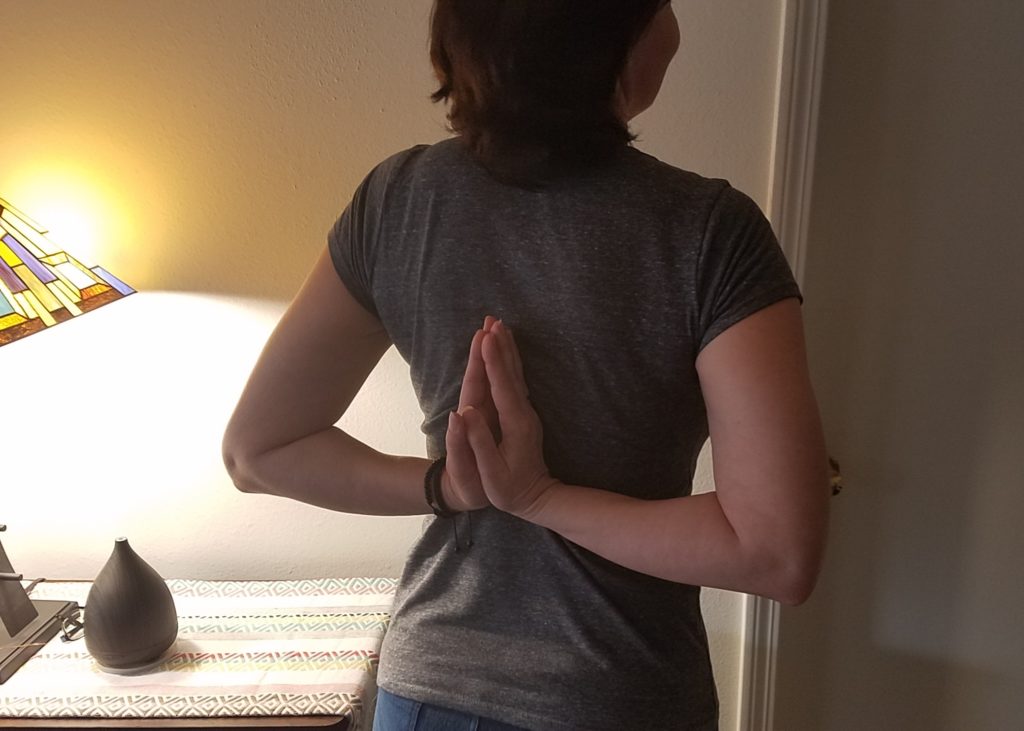
That is me.
Why does this picture mean so much to me?
We all take small things for granted, like tying a knot or driving a car. We learn how to do it, and after a while do not think about it anymore.
But suddenly, nothing works as it used to.
That is what happened to me.
3 years ago, I woke up with some sudden pain in my right shoulder. Then, it disappeared and came back the next day, then again, and again. For a long time, it came back between 7-9 am and faded later.
Slowly, I was not able to do ordinary things like writing with a pen, driving my stick shift car, turning my head easily, or hooking my bra at my back.
I had to give up cookie decorating because I could not squeeze out the icing from the icing bag.
I could not even sleep because turning was painful.
My work as a web designer was in jeopardy, which means that everything I worked for and everything I know is dependent on using my hand and that hand was giving up on me.
Pain is a tricky subject.
Pain is something that hard to explain, and hard to measure.
I was in pain. Sometimes it was endurable, other times it was crushing me.
The doctor told me that he could not see anything and that I should take Advil or can go to see other doctors; probably I would be given a Lidocaine injection, but I did not want to take that as an answer.
That was the first time that I went to see Dr. Moncton and Westboro Spine & Holistic Health Center to receive chiropractic treatments. He showed me how rotated my spine and my posture was. It was shocking. Dr. Moncton patiently worked on me for several months even though I was not really a great patient. I was that patient who was afraid of the noises my body gave, but I felt better, day by day. Thank you Dr.Moncton!
Then, I tried out acupuncture for the first time in my life at Northborough Acupuncture and Wellness Center, and it was a miracle. Diana Jones’ knowledge and passion were amazing to experience. I noticed instant changes in my range of motion and became aware of other changes in my body as well. Thank you, Diana!
Later I learned about Carol Peronace Waite ‘s yoga classes, Yoga with Carol, and her scoliosis workshop where I learned poses to stretch out my spine and strengthen my back muscles. I incorporated these poses into my workout routine ever since. Thank you Carol!
It has been over a year now, and I can say that I am back to normal.
I am so grateful for all of these people and their passion to help others.
There is no day when I do not think gratefully about all my experiences with them.

Now you understand why putting on my bra is a big deal for me
A moodboard in the web design process is a really powerful element to communicate feelings and information that can be hard to describe. It allows a new client to show what images, colors, graphics or typefaces she likes without searching for hours and hours and downloading or sending the URLs or images.
The process of how we design websites is changing all the time. There was a time when we did not have to worry about the different browser sizes because there were only desktop monitors and that was all. Not any more.
I have been using moodboard for a while, but not Pinterest. I should say I was ignorant of the usefulness of Pinterest. Nowadays I use it to begin most of my web design projects.
A moodboard is a collage of different design elements, colors, examples, patterns, images, or any inspirational elements. It is practical but mostly inspirational for both clients and designers. A board does not have any actual design elements of the new website but would establish the color scheme, the tone of the site.
Both of these were created for the same client after she showed me her Pinterest board. There were two distinct styles I could separate. To make sure I use the one that she liked the most, I created two images for her to chose from. One with the airy light seaside theme and the other using earthy colors and warmer elements.


I also included some practical elements like button designs and typefaces so I save time in the future design process and we do not have to come back to choose the fonts again.
Can you see how this can help in the creative process?
It also saves a lot of time because I already know what color palette she expects to see.
Check out the final website to see the finished project. wendyhyattwellness.com
As a web designer, it is really a fun and helpful way to start working on a new website. It gives a ton of inspirations and helps to understand what the client is actually looking for. The style the sense and the feeling she will be happy to see on her own site.
Mood boards are inherently valuable to the web design process to help start defining a general visual language and start getting an idea of what a client likes or dislikes. In our experience, it pays to give this piece of process more attention than it often receives. By spending the effort to make your mood boards more detailed, substantial, and designed, you’ll build a stronger foundation, gather better feedback, and better position the whole project.
Our beloved Lysa Miller, 3 Media Web invited me to do a presentation for her amazing MetroWest Women Networking event.
I was happy to accept the invitation because doing a SEO workshop for small businesses was one of my yearly goals.
I have learned so much, over the last couple of years, studying various website source codes, which were designed either by professional web designers or amateurs. In mind educator mind summarized most mistakes and badly wanted to tell people about. So I already had a presentation in my mind when we started talking about the event with Lysa.
I just had to choose a good name and the title became: DIY your SEO.
The presentation was about the major mistakes people make building a website and don’t know anything about how Google works and how Google goes through the content on a single page.
Writing great content and creating a website and keep all the tools and advises in mind is really difficult. There are different professionals who are specialized in each of the small pieces.
There are people for Marketing Strategy, Content Writing, Social Media, Website Design, Content Strategy and SEO and you name it, it exists and people are great doing it.
But small business owners want to do all of these on their own. They learn how to design websites, they write a copy for their home page and services page, they take pictures, the write social media posts and blog posts.
They do it all!!
Congratulations to all of you who are doing it all for your small business!
If you think you need some help with your website SEO, ask for a 2-hour SEO consultation because it will help you a lot!